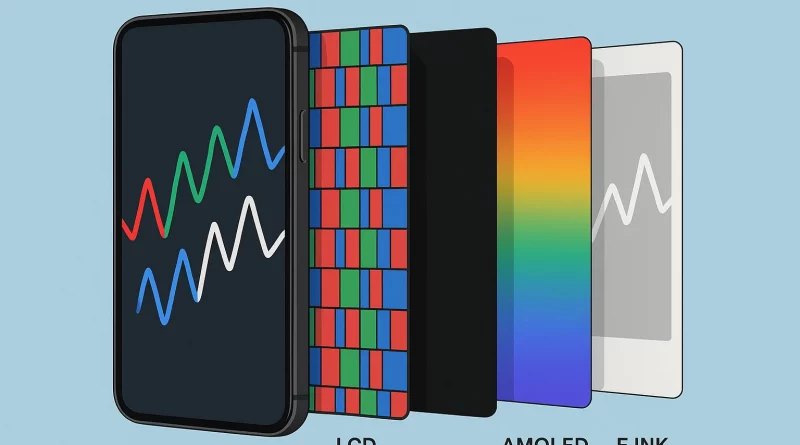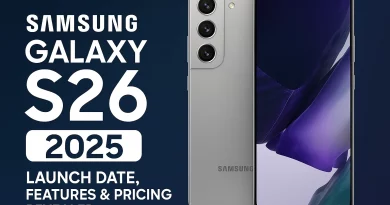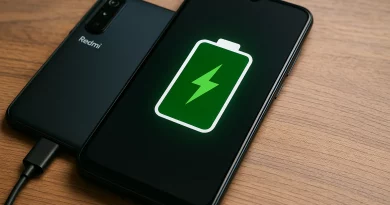How Smartphone Screen Works | Types of Display | Complete Explanation
Think about it: how many times a day do you tap, swipe, and pinch your smartphone screen? Probably thousands! It feels like magic, doesn’t it? You touch the glass, and instantly, something happens on the screen. But have you ever stopped to wonder what’s really going on beneath that smooth surface?
Your smartphone screen isn’t just one simple piece of glass. It’s actually an amazing stack of three different layers, all working together perfectly. This “sandwich” of technology is one of the coolest parts of your phone, letting you interact with it almost without thinking.
In this article, we’ll pull back the curtain and show you exactly how your smartphone screen works. We’ll explore the tough glass on top, the clever part that senses your touch, and the brilliant display that shows you everything. We’ll also dive into the different kinds of display technologies you’ll find in today’s phones.
The Tough Outer Layer: Chemically Strengthened Glass
The first thing you touch on your phone is the glass. You might think it’s just regular glass, but it’s much tougher. This special kind of glass is called chemically strengthened glass. Famous examples include Gorilla Glass, which you might have heard of.
So, how do they make glass so tough? It’s a bit like a chemical magic trick! The glass goes through a process called ion exchange. Here’s how it works:
How Ion Exchange Makes Glass Stronger
Imagine tiny atoms inside the glass. The glass is heated in a special liquid bath filled with much larger atoms, usually potassium. When the glass gets hot, the smaller atoms (like sodium) inside the glass start to move out of the surface. At the same time, the larger potassium atoms from the liquid bath rush in to take their place.
Important: These larger potassium atoms squeeze into the spots left by the smaller sodium atoms. This squeezing creates a strong “compression layer” on the surface of the glass. Think of it like a spring that’s been tightly pushed down – it’s much harder to break or scratch because it’s already under pressure.
This compression on the surface is what makes your phone screen incredibly resistant to scratches from keys or coins in your pocket, and helps it survive small drops. While no glass is unbreakable, chemically strengthened glass gives your phone a much better chance of survival than regular glass would.
Sensing Your Touch: The Projected Capacitive Touch Grid
Underneath the super-tough glass is where the real “touch” magic happens. This layer is called a projected capacitive touch grid. Sounds complicated, right? Let’s break it down simply.
Think of this layer as a grid of tiny, invisible electrical wires. These wires create an electric field across the entire screen. When your finger touches the screen, something interesting happens:
How Your Finger Becomes Part of the Circuit
Your body is a conductor of electricity, meaning electricity can flow through it. When your finger touches the screen, it actually changes the electric field at that exact spot. The small change in electricity is picked up by sensors.
Millions of Tiny Capacitors
The “capacitive” part comes from tiny components called capacitors. Capacitors are like tiny batteries that can store a small electrical charge. In your phone screen, millions of these tiny capacitors are arranged in a grid. Each point where two “wires” in the grid cross forms a tiny capacitor.
When your finger touches the screen, it draws away a tiny bit of the electrical charge from these capacitors. The phone’s brain (the processor) quickly figures out where this change happened by looking at which capacitors lost charge. This is how your phone knows exactly where you touched!
This technology is also why you can use multiple fingers at once for things like “pinch-to-zoom.” The grid can sense several changes in the electric field at the same time, allowing for these “multi-touch” gestures.
Types of Display Technologies
The third major layer in your smartphone screen stack is the display itself. This is what brings the images, videos, and apps to life. Over the years, different technologies have been used to create these vibrant visuals. Let’s look at the most common ones you’ll find today.
1. LCD (Liquid Crystal Display)
For a long time, LCDs were the most common type of display in smartphones. They work differently from how pixels light up by themselves.
How LCDs Work
An LCD screen is made up of several layers. The main parts are:
- Backlight: This is a light source (usually LEDs) that shines light through the entire display.
- Liquid Crystal Layer: This layer contains tiny liquid crystals. When an electrical current is applied to these crystals, they twist. This twisting changes how much light from the backlight passes through them.
- Color Filters: After passing through the liquid crystals, the light goes through red, green, and blue color filters to create the final color of each pixel.
LCDs are known for being bright and generally more affordable to produce. However, because they rely on a constant backlight, they can’t show “true black.” Even when a pixel is meant to be black, some light still leaks through.
2. OLED (Organic Light-Emitting Diode)
OLED is currently the most popular high-end display technology used in many premium smartphones.
How OLEDs Work
OLED stands for Organic Light-Emitting Diode. The key difference here is that each individual pixel in an OLED screen actually produces its own light. It doesn’t need a separate backlight.
Important: Because each pixel can turn itself on and off completely, OLED screens can show “true black.” When a pixel is black, it’s literally off, so it produces no light at all. This gives OLED screens amazing contrast, making colors pop and images look incredibly vibrant and lifelike. They also use less power when displaying darker colors because pixels are off.
OLED displays are also very thin and flexible because they don’t need that separate backlight. This allows phone makers to create sleeker, lighter phones, and even foldable screens. The technology behind making these pixels light up involves very specific organic (carbon-based) materials, some of which are based on Nobel Prize-winning research!
Microscopic Lights and Dimmer Switches
Imagine over 10 million tiny light bulbs, each with its own dimmer switch, all living beneath your fingertips. That’s essentially what an OLED screen is. Each pixel is made up of red, green, and blue sub-pixels. By controlling the brightness of each of these tiny colored lights, your phone can create any color you can imagine.
3. AMOLED (Active Matrix Organic Light-Emitting Diode)
AMOLED is an advanced type of OLED display. Most “OLED” screens in modern smartphones are actually AMOLED.
AMOLED’s Advantage: Faster Control
The “AM” in AMOLED stands for “Active Matrix.” This means there’s a thin-film transistor (TFT) behind each pixel. This TFT acts like a tiny, individual switch that quickly controls whether each pixel is on or off, and how bright it is.
This active control makes AMOLED displays:
- Faster: They can change pixels much quicker, leading to smoother animations and better performance in fast-paced games or videos.
- More Power Efficient: Especially when displaying complex moving images, as each pixel can be precisely controlled.
Why This Technology Stack Matters
The smartphone revolution wasn’t caused by a single, amazing invention. Instead, it was sparked by bringing together several existing technologies – like tough glass, advanced touch sensing, and brilliant displays – and making them work together in a super smooth and easy-to-use way.
This combination created a human-centered design. It means the phone was designed to be used naturally by people, with simple gestures and clear visuals. It’s a brilliant mix of microelectronics, atomic chemistry, and display physics, all packed into the screen you use every single day without even thinking about it.
It’s a testament to how complex engineering can result in something so simple and powerful in our hands.
Frequently Asked Questions (FAQs)
What is the main difference between OLED and LCD screens?
The main difference is how they produce light. LCD screens use a backlight to shine light through liquid crystals, which then create the image, meaning even “black” areas might still have some light. OLED screens have pixels that light up individually. When an OLED pixel needs to be black, it simply turns off completely, leading to much deeper blacks and better contrast.
Why do some touchscreens not work with regular gloves?
Most modern smartphones use capacitive touchscreens. These screens work by sensing the tiny electrical charge from your finger. Regular gloves are insulators, meaning they block this electrical charge. So, the screen can’t detect your touch. Special gloves with conductive tips are designed to pass this charge through, allowing you to use your phone with them on.
What is “Gorilla Glass”?
Gorilla Glass is a brand of chemically strengthened glass made by Corning. It’s widely used in smartphones, tablets, and other devices because it’s highly resistant to scratches and impacts. It gets its strength from a special “ion exchange” process where smaller ions in the glass are replaced by larger ones, creating a compressed, stronger surface layer.
Can a smartphone screen be repaired if it breaks?
Yes, smartphone screens can often be repaired or replaced if they break. However, it’s usually a job for trained technicians, as the process involves carefully separating the display layers and installing new components. The cost can vary depending on the phone model and the extent of the damage.
How do multi-touch gestures like pinch-to-zoom work?
Multi-touch gestures are possible because the projected capacitive touch grid can detect multiple points of contact at the same time. When you pinch or spread two fingers, the screen’s sensors identify both touch points and the distance between them. The phone’s software then translates this movement into actions like zooming in or out on an image or map.
What makes OLED screens better than LCD?
OLED pixels light themselves. This gives deeper blacks and higher contrast. LCDs always use a backlight, so blacks look grayer.
Why do some screens burn in?
Burn‑in happens when pixels age unevenly. OLED screens can suffer burn‑in if the same image stays too long. Newer models use software fixes to reduce it.
Can MicroLED replace OLED?
MicroLED has great potential. It combines OLED’s deep blacks with higher brightness and no burn‑in. But it’s costly now and not yet common in phones.
How do touch sensors detect my finger?
Most phones use a capacitive layer. Your finger changes the electric field. The screen senses that change and tells the phone where you touched.
Are higher refresh rates worth it?
Yes, if you play fast games or scroll a lot. A 90 Hz or 120 Hz screen refreshes more times per second. This makes motion appear smoother.
Conclusion
Your smartphone screen is far more than just a piece of glass. It’s a complex, multi-layered marvel of engineering. From the tough, chemically strengthened glass that protects it, to the projected capacitive grid that senses your every touch, and finally, to the brilliant display technologies like LCDs and OLEDs that bring images to life, each part plays a crucial role. This amazing combination is what makes your daily taps, swipes, and pinches feel so seamless and magical, truly connecting you to the digital world.



